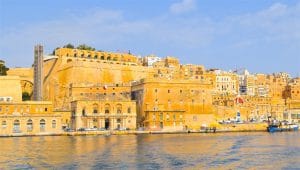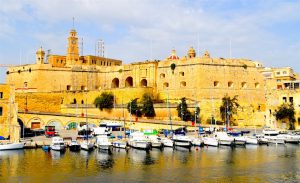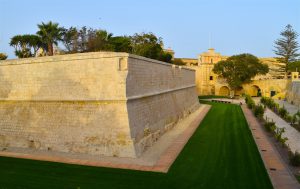It is possible to have an immersion in Malta in a well-planned three-day and 3-night stay, based in the capital city of Valletta. It is always summer in Malta, making it a pleasant year-around stopover between cruises. From the Rome Fumicello airport, the flight to Valletta is only an hour, available on Alitalia.
Cabs are plentiful from the airport to Valletta for €15. If you plan to stay on the beach, head directly to San Pawl Beach from the airport for €25. San Pawl Beach is lovely, although a distance to Valletta, making it a great destination for a longer stay. In Valletta, the hotels are small, the B & Bs plentiful, and the city walkable. Renting a car is never advised for a stay in the old walled city of Valletta. The streets are narrow and steep. Parking spaces become available about as often as rainy days in Malta, which is almost never.
Choose to arrive early in the day in order to have maximum time to walk the walled city. From the New Parliament Square at the entrance to the old, walled city, from 19th century Valletta, to Fort St. Elmo, at the opposite end of the city, is a 15-minute easy walk. It is downhill. To walk back uphill, plan to walk San Pawl Street, which has long, wide, tread stairs, or walk up the broad and lively Merchant Street, with all the shops that are open until late.
When walking the length of the city take in the side streets, with colorful balconies. Valletta is in a constant state of renovation, with more apartments being created behind centuries old facades. Coffee shops selling pastry, like Croce Bonaci, are plentiful, rivaled only in number by churches.
Fort St. Elmo still sits at the entrance to the Grand Harbor, looking much revived from the time in 1564 when it served as the last bastion of the Knights of St. John, under assault by Janissaries of Sultan Suleiman the Magnificent. Today the fort houses the National War Museum. Each building in the fort is dedicated to a separate era of siege and warfare from ancient times, to the Knights, then World War I and II. The exhibits are well done, with ample interpretive signage in English. A ticket to the museum is also good for other attractions.
From the rooftops of Fort St. Elmo there are great vistas of Valletta and the Grand Harbor, which feeds into the Three Cities across the bay. When leaving the fort, walk along the wall above the water to the Neo-classical Siege Bell War Memorial. Next, cut inland on St. Nicholas Street up to Repubblica Street and the Victorian era British hotels, restaurants, and faded glory of the Caffe Cordina pastry shop. There is even a Marks and Spencer on the cross street, Old Theatre Street.
At the cross roads of Old Theatre Street and Repubblica Street is the Palace of the Grand Master of the Knights of St. John. Today it houses the ceremonial rooms of the former Parliament and President’s Palace. The main attraction here is the Palace Armoury, with a well-stocked display of medieval armor and low-tech weapons. Across the street enjoy a meal at StrEat Whisky Bar & Bistro, where the plates are plentiful and dining in the backstreet is delightful at night.
A walk further down Repubblica Street leads past the National Library, with the statue of Queen Victoria in front, the National Museum of Archaeology, and ends at the New Parliament Building and the statue of Knights of St John Grand Master, and city namesake, Jean Vallette. The walk has returned to the entry gate to the city. At this point turn toward the harbor to enter the cool Upper Barrakka Gardens and a peaceful overlook of the harbor that belies its history.
The marble arcade along the garden is filled with memorials to British and American soldiers who gave their lives in defense of Malta in both World Wars. Below the arcade visitors can tour the Lascaris War Rooms, where the hidden Allied command center based operations defending Malta during bombardment. At the end of the arcade is the entrance to the Barakka Lift. The trip down the lift to the harbor is free. The trip back up to the garden is €1.
On day two take the Barakka Lift down to the Grand Harbor and board a ferry for less than €4. The ferries run across the bay to the three cities of Kalkara, Birgu, and Cospicua. The three cities open like three fingers into the Grand Harbor. The ferry stops at Birgu, across from the Malta War Museum.
The center city and most notable of the three is Birgu. At the end of the city is Fort Saint Angelo, which played its part in the story of the siege of Malta in the time of the Knights of St. John. Today the fort looks over the moorings of some of the most glamorous yachts in the world.
On day three take the city bus for €2 across the north side of the island to the ferry to Gozo. A round trip ferry ticket is €6. The pleasant ride is about 20 minutes. From there take a local bus on the bone jarring streets to the capital of Victoria.
Victoria is a smaller version of Valletta, also built of limestone. The citadel rises above the city center. A walk up the slope leads to the interior fort, mostly preserved as an archaeological site. There is a cathedral, a café, a small museum and a few shops. Downhill is a main square, another museum, and a cathedral.
Notably Victoria, like Valletta, is a clean city, where visitors walk the streets feeling safe. Locals are proud of their heritage. Their economy depends on tourists. In our travels we meet several British vacationers who have been coming to Malta since they were children. They complain of the increase in tourists, but are pleased with the constant welcome they receive in this warm and sunny haven.
Returning to Malta on the ferry, take the bus to M’dina in the center of the island. M’dina was the ancient capital of Malta until the arrival of the Knights. The Knights preferred the coastal view.
Today the walled city of M’dina sits within a grassy moat, beautifully preserved. The old streets meander from wall to wall, taking visitors past shops and restaurants. The ambience in M’dina is upscale and elegant, the sort of prominence the capital would have commanded in the 15th century.
Around the outside of M’dina is the supporting suburb of Rabat. Here too the ancient streets are narrow and winding. These were homes of the common folk who worked to support the needs of the ancient capital city. The pride of locals today is the Cathedral of Saint Pawl in the center of Rabat. In 60 AD when the Apostle Paul shipwrecked on the beach, now a beach resort area, he was taken to this spot to recuperate in the safety of a cavern. The cathedral was later built over the cavern. On weekdays visitors can tour the underground sacred area.
At €2 a ride, the buses are a great way to tour Malta, riding between the cities. The limestone landscape is harsh. It is easy to understand the two millenniums long relationship between Malta and Sicily, the source of grain to feed the Maltese. Today locals speak Maltese with a Sicilian inflection. Restaurants across the island offer local rabbit and pasta, traditional Maltese/Sicilian style.
Read the stories of Malta and the Knights of St. John in Cruise through History, Itinerary III, Rhodes, and Itinerary V Malta, coming soon, available at Amazon.com.













